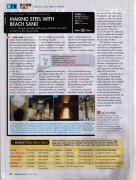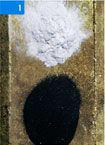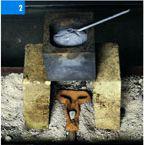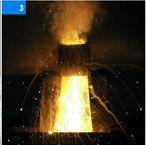| Making Steel with Beach SandThermite powder yields pure, white-hot iron when lit. Don't try this one at home. |
| |
|
| |
In high school, my social studies teacher talked about a substance that could generate heat so intense that a bag of it lit on the hood of a car would melt right through the engine block. Cool, eh? A Vietnam vet, he said that in the war they used blankets of the stuff to destroy sensitive equipment before capture by melting it into a puddle. (Putting holes in the odd jeep engine was just for fun.)
The substance was thermite, which I assumed was a complicated, exotic explosive developed by the military. Turns out it is exotic, but for the opposite reasons: It's incredibly simple, it's incendiary not explosive, and its main application is in building train tracks, not melting spy gear.
In the thermite reaction, iron oxide is stripped of its oxygen atoms to become iron metal. The process requires a lot of energy because iron binds oxygen tightly. Where does this energy-plus the energy needed to heat the pure iron to nearly twice its melting point-come from? From a chemical that binds oxygen atoms far more tightly than iron, releasing enormous amounts of energy when it acquires the atoms. And what is this highly reactive substance, one of the most powerful reducing agents available? Aluminum.
Thermite is simply a mixture of iron oxide (like the magnetite sand I discussed last month) and aluminum powder, which I buy commercially. (Incidentally, it's also the stuff that creates the image inside an Etch A Sketch.)
I used about a pound of thermite to create a T-handle on the end of a 3/4-inch bolt. The thermite was ignited in a graphite crucible, and the resulting half a pound of white-hot molten iron fell through a hole in the bottom into a simple clay form I had built around the bolt. The metal was so hot it melted into the end of the bolt, forming a single continuous piece of steel.
The reaction is not an explosion, but to call it vigorous would be an understatement: The mixture burns like a superhot roman candle, consuming a pound of powder in a few seconds. It's so hot it will set on fire just about anything it touches, including me, so I ignited it in a wide-open outdoor space and watched from about 20 yards back.
Incredibly, even today this is how sections of high-speed rail are welded into seamless track, right down to the sparkler used to light the mixture. A ceramic funnel containing about 10 pounds of thermite is set off over the junction between two sections of track, fusing them into a single piece. There are few other portable ways to produce the heat necessary to do that.
Scan of printed version:
 |
| |
|
| |
|
| |

The ingredients: aluminum powder (top) and magnetite (bottom).

A plug of aluminum foil keeps the thermite powder from falling through the hole in the bottom of this crucible, which is held above a clay form. The fuse is a common Fourth of July sparkler.

Ignition! The thermite burns itself up in a few seconds, and the molten iron that's produced melts through the plug and falls into the form.

The result is a solid steel handle firmly fused to the bolt, which partially melted at the point of contact.
Photo Credits:
Jeff Sciortino
Jeff Sciortino
Jeff Sciortino
Jeff Sciortino
|
|